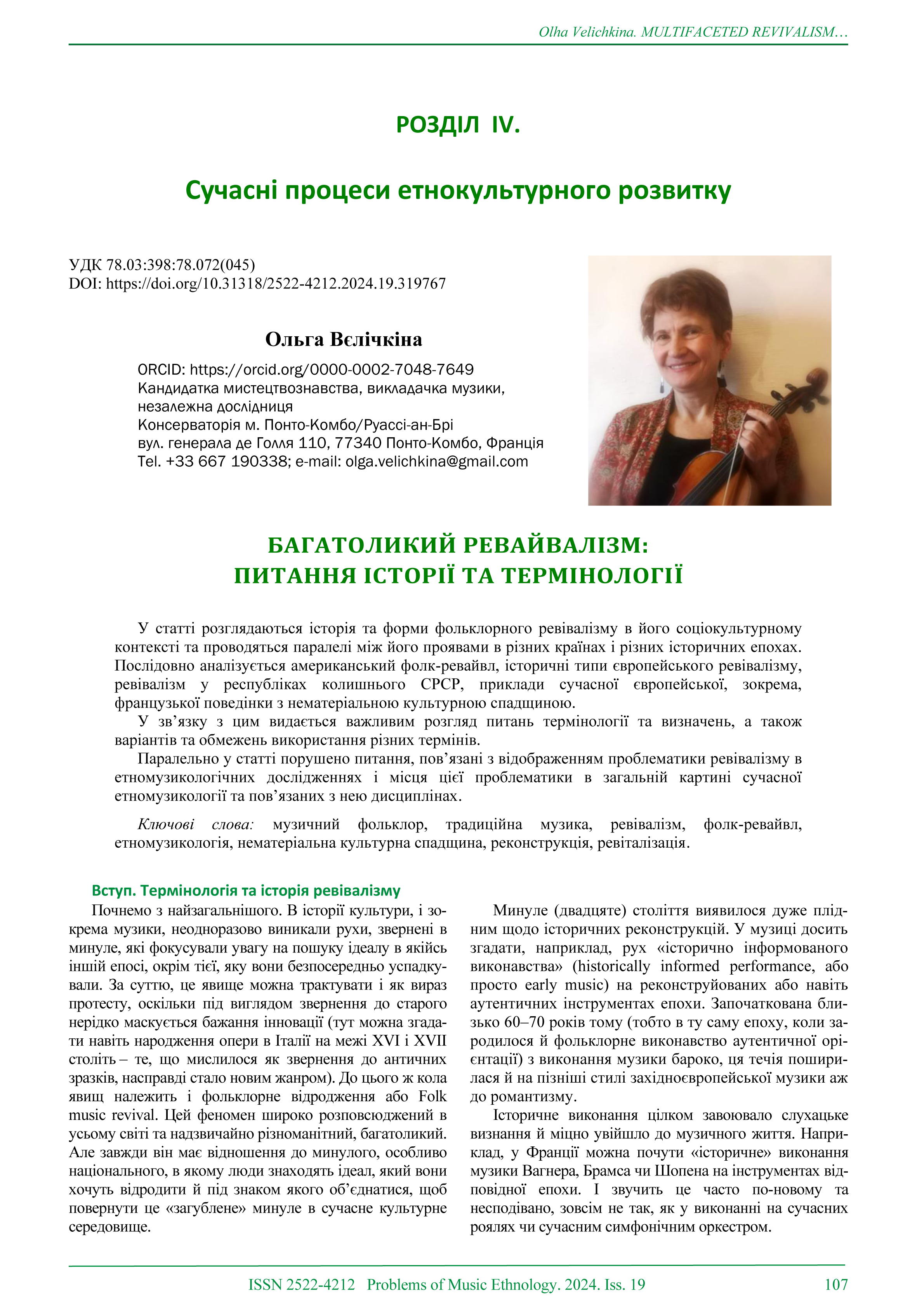Багатоликий ревайвалізм: питання історії та термінології
Багатоликий ревайвалізм: питання історії та термінології
DOI:
https://doi.org/10.31318/2522-4212.2024.19.319767Ключові слова:
музичний фольклор, традиційна музика, ревівалізм, фолк-ревайвл, етномузикологія, нематеріальна культурна спадщина, реконструкція, ревіталізаціяАнотація
У статті розглядаються історія та форми фольклорного ревівалізму в його соціокультурному контексті та проводяться паралелі між його проявами в різних країнах і різних історичних епохах. Послідовно аналізується американський фолк-ревайвл, історичні типи європейського ревівалізму, ревівалізм у республіках колишнього СРСР, приклади сучасної європейської, зокрема, французької поведінки з нематеріальною культурною спадщиною. У зв’язку з цим видається важливим розгляд питань термінології та визначень, а також варіантів та обмежень використання різних термінів. Паралельно у статті порушуються питання, пов’язані з відображенням проблематики ревівалізму в етномузикологічних дослідженнях і місця цієї проблематики в загальній картині сучасної етномузикології та пов’язаних з нею дисциплінах.
Завантаження
Посилання
Allen, Ray (2010). In Pursuit of Authenticity: The New Lost City Ramblers and the Postwar Folk Music Revival, Journal of the Society for American Music, V. 4(3), 277–305. Cambridge: Cambridge University Press. DOI: https://doi.org/10.1017/S1752196310000155 [in English].
Arom, Simha (1976). The use of play-back techniques in the study of oral polyphonies, Ethnomusicology, 20(3), 483–519. Illinois: University of Illinois Press. DOI: https://doi.org/10.2307/851046 [in English].
Arom, Simha (1991). A synthesizer in the Central African bush. A Method of Interactive Exploration of Musical Scales. In: Constantin Floros et al. (Hg.). Für Ligeti. Die Referate des Ligeti-Kongresses Hamburg 1988, p. 163–178. Laaber, Laaber-Verlag [in English].
Arom, Simha (2004). [1991/2010]. African Polyphony and Polyrhythm: Musical Structure and Methodology. Cambrige: Cambrige University Press. DOI: https://doi.org/10.1017/CBO9780511518317 [in English].
Barz, Gregory F. and Timothy J. Cooley (Eds.). (1997). Shadows in the Field: New Perspectives on Fieldwork in Ethnomusicology. New York: Oxford University Press. [in English].
Baumann, Max-Peter. (1996). «Folk Music Revival : Concepts between Regression and Emancipation». Dans: The World of Music, Vol. 38, No. 3, 71–86. VWB, Berlin. [in English].
Bohlman, Philipp (2019). Wie sängen wir Seinen Gesang auf dem Boden der Fremde? Jüdische Musik des Aschkenas zwischen Tradition und Moderne, LIT Verlag [in German].
Dorson, Richard M. (1973). Is folklore a discipline? Folklore [Journal of the American Folklore Society], Vol. 84, N°3, 177–205. [in English].
Feld, Steven (1982). Sound and Sentiment: Birds, Weeping, Poetics, and Song in Kaluli Expression. Durham: Duke University Press. DOI: https://doi.org/10.2307/j.ctv113180h [in English].
Garakanidze, Ed. (1989). Nekotorye voprosy ispolnitel'stva gruzinskoj narodnoj pesni i ansambl' "Mtiebi" [Some issues of Georgian folk song performance and the Mtiebi ensemble]. Tradicionnyj fol'klor: sovremennye narodnye hory i ansambli [Traditional Folklore: Contemporary Folk Choirs and Ensembles], 124–132. Leningrad [in russian].
Hagmann, Lea et Franz Andres-Morrissey (2018). «Multiple Authenticities of Folk Songs». In: Thomas Claviez, Kornelia Imesch and Britta Sweers (Eds.). Critique of Authenticity. p. 183–206. Wilmington: Vernon Press URL: https://boris.unibe.ch/id/eprint/129277 [in English].
Hill, J., & Bithell, C. (2014). An Introduction to Music Revival as Concept, Cultural Process, and Medium of Change. In: Caroline Bithell, Juniper Hill (Eds.). The Oxford Handbook of Music Revival, pp. 3–42. Oxford, Oxford University Press. DOI: https://doi.org/10.1093/oxfordhb/9780199765034.013.019 [in English]. Online access: URL: https://pure.manchester.ac.uk/ws/portalfiles/portal/62635531/An_Introduction_to_Music_Revival_AAM_.pdf (access 25.12.2024)
Hood, Mantle (1960). The challenge of bi-musicality. Ethnomusicology, 4(2) (May), 55–59. Illinois: University of Illinois Press DOI: https://doi.org/10.2307/924263 [in English].
Kel'mickajte, 3ita (1984). Iz opyta raboty fol'klornyh ansamblej Litvy (voprosy teorii i praktiki) [From the experience of Lithuanian folklore ensembles (issues of theory and practice)]. In: Tradicionnyj fol'klor v sovremennoj hudozhestvennoj zhizni. Fol'klor i fol'klorizm [Traditional Folklore in Modern Artistic Life. Folklore and Folklorism]: Collection of scientific works of LGITMiK, p. 111–115. Leningrad [in russian].
Léotar, Frédéric (2011). Réflexion sur les enjeux éthiques de la collecte en ethnomusicologie. Cahiers d’ethnomusicologie, 24, 27–43. Geneva, ADEM. [in French].
Livingston, Tamara (1999). Music revivals: Towards a general theory. Ethnomusicology. Vol. 43, No. 1 (Winter), 66–85. Illinois: University of Illinois Press. DOI: https://doi.org/10.2307/852694 [in English].
Morgenshtern, Urlih (2014). «Oficial'naja narodnost'» v istoricheskom instrumentovedenii sovetskogo perioda [«Official Folk» in historical organology of the Soviet period]. Voprosy instrumentovedenija [Issues in Organology]. Iss. 9: Blagodatovskie chtenija [Blagodatov’s readings], 104–111. St Petersburg. [in russian].
Morgenstern, Ulrich (2017). Imagining social space and history in European folk music revivals and volksmusikpflege: The politics of Instrumentation. In: Ardian Ahmedaja (Ed.). European Voices III : The Instrumentation and Instrumentalization of Sound. Local Multipart Music Cultures and Politics in Europe, 263–292. Wien Köln Weimar: Böhlau verlag. [in English].
Morgenstern, Ulrich (2018). Music without social life: the garmon’ player Mikhail Sorochinsky – a non-revivalist musician in Smolensk province. Traditiones, 47/2, 35–67. [in English].
Morgenstern, Ulrich (2019). The role and development of musical instruments in European folk music revival and revitalization movements. some common trends. In: Ambrózová, J. - Garaj, B. (Eds.). Traditional Music and Dance in Contemporary Culture(s), 10–27. Nitra: Constantine the Philosopher University [in English].
Pettan, Svanibor and J. T. Titon. (Eds.). (2015). Oxford Handbook of Applied Ethnomusicology. Oxford and New York: Oxford University Press [in English].
Shevchuk, Ol. (2006). Ansambli naukovo-etnohrafichni [Scientific ethnographic ensembles]. In: Ukrainska muzychna entsyklopediia [Ukrainian Music Encyclopedia]. V. 1: [A – D], 69–70. Kyiv: Publishing House of the Institute of Art History, Folklore and Ethnology of the National Academy of Sciences of Ukraine [in Ukrainian].
Skazhenyk, M. (2024). Folklorystychni hurty Kyieva pershoi chverti khkhi stolittia: shliakhy tvorchoi realizatsii [Folklore groups of Kyiv in the first quarter of the twentieth century: ways of creative realisation]. In: Narodno-muzychne mystetstvo ukrainy XXI stolittia: stsenichno-vykonavskyi, metodyko-pedahohichnyi aspekty [Folk Music Art of Ukraine of the Twentieth Century: Stage-performance, Methodological and Pedagogical Aspects], pp. 175–245. Kyiv [in Ukrainian].
Titon, Jeff (2015). What is Applied Ethnomusicology & Why Did They Say so Many Terrible Things About it? Library of Congress lectures [in English]. URL: https://www.loc.gov/item/2021692311/ (access 25.12.2024)
Velitchkina, Olga (2016). «L’ethnomusicologie chantante»: Cas d’implication des chercheurs dans le mouvement revivaliste en Union Soviétique et en Russie. Cahiers d’ethnomusicologie. Vol. 29, 37–53. Genève, ADEM [in French].
Yurchak, Alexei (2006). Everything Was Forever, Until it Was no More. The Last Soviet Generation. Princeton-Oxford : Princeton University Press [in English].
Zemp, Hugo (1996). The/An Ethnomusicologist and the Record Business. Yearbook for Traditional Music. Vol. 28, 36–56. Cambridge: Cambridge University Press. DOI: https://doi.org/10.2307/767806. [in English].
Zhulanova, N. (1999). Molodezhnoe fol'klornoe dvizhenie [Youth folklore movement]. In: Samodejatel'noe hudozhestvennoe tvorchestvo v SSSR: Ocherki istorii. Konec 1950-h – nachalo 1990-h godov [Amateur Artistic Creativity in the USSR: Sketches of History. The End of the 1950s – the Beginning of the 1990s], pp. 107–133. St. Petersburg: Dmitry Bulanin [in russian].

##submission.downloads##
Опубліковано
Номер
Розділ
Ліцензія
Починаючи з червня 2025 року авторське право на публікацію залишається за авторами.
Автори можуть використовувати власні матеріали в інших виданнях за умови посилання на журнал «Проблеми етномузикології» як на місце першої публікації.
Наш журнал дотримується авторських прав та дозволів CREATIVE COMMONS для журналів із відкритим доступом.
Автори, які публікуються в цьому журналі, погоджуються з такими умовами:
- автори лишають за собою право на авторство своєї роботи та передають журналу право першої публікації цієї роботи на умовах ліцензії Creative Commons Attribution-ShareAlike 4.0 International License, яка дає змогу іншим особам вільно поширювати опубліковане дослідження з обов'язковим посиланням на авторів оригінальної роботи та першу публікацію роботи в цьому журналі;
- автори мають право укладати самостійні додаткові угоди щодо неексклюзивного розповсюдження роботи такою, якою її було опубліковано цим журналом (наприклад, розміщувати роботу в електронному сховищі установи або публікувати у складі монографії), за умови збереження посилання на першу публікацію роботи в цьому журналі.



